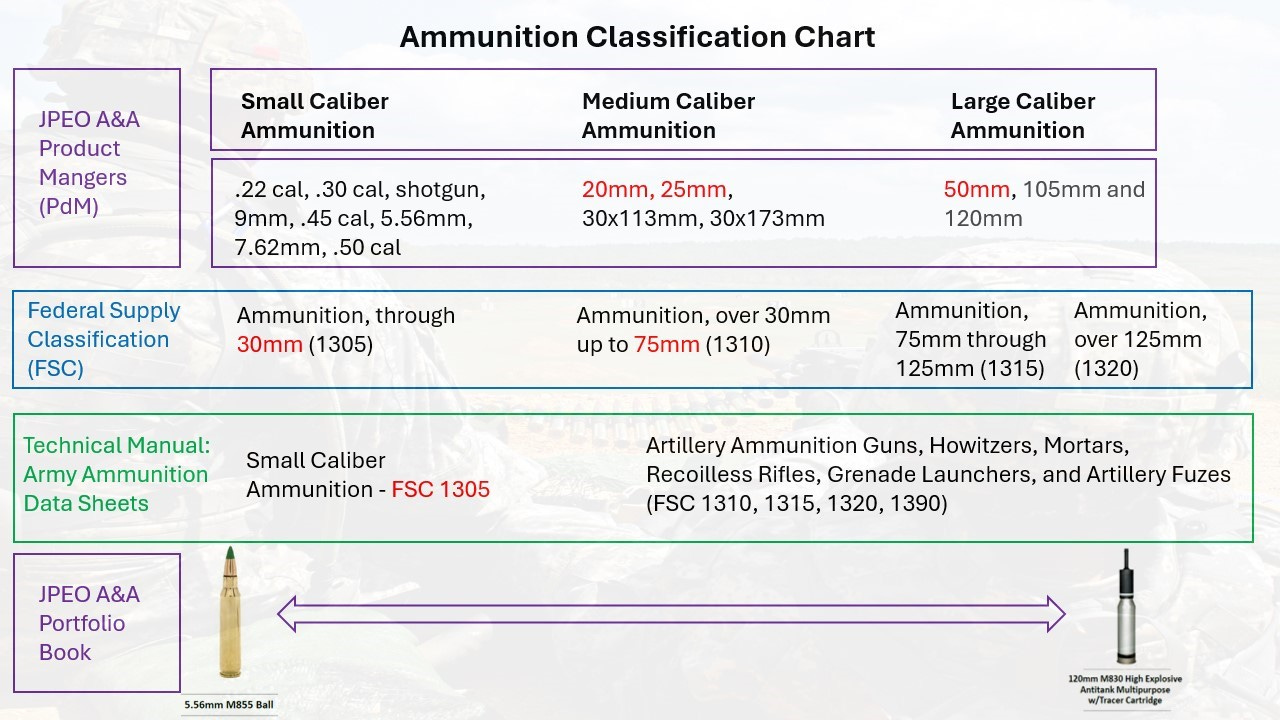Ammunition Classification: Small, Medium, and Large Caliber Ammunition
There is often debate about what ammunition is considered small, medium, and large caliber. In the context of military munitions, 5.56mm is considered small, while 120mm is considered large. Often, the munitions that extend between small to medium and medium to large categories are contested.
The disagreement depends on the context and situation of the munitions in the discussion. Acquisition, Supply, and Surveillance are the three most common diversions. I highlight the three diversions and, in red, the disputed areas in the Ammunition Classification Chart.
Figure 1. Ammunition Classification Chart.
Acquisitions
Joint Program Executive Office Armaments & Ammunition (JPEO A&A) is designated as the Single Manager for Conventional Ammunition (SMCA) Executor is designated as the Single Manager for Conventional Ammunition (SMCA) Executor. Its objective is to achieve effectiveness and efficiency in the DoD operations required to acquire conventional ammunition. To that end, JPEO A&A is comprised of seven project offices, one of which includes Project Manager Maneuver Ammunitions Systems.
The Project Manager Maneuver Ammunitions Systems (PM MAS) provide all direct fire combat and training ammunition capabilities and have unique Direct Report Mission Areas. There are three product management areas responsible for life cycle management, including research, development, product improvement, production, fielding, testing, environmental assessment/remediation, and organic manufacturing facility expansion and modernization.
Product Manager Small Caliber (PdM SCA) for .22 cal, .30 cal, shotgun, 9mm, .45 cal, 5.56mm, 7.62mm, .50 cal.
Product Manager Medium Caliber (PdM MC) for 20mm, 25mm, 30mm and 40mm.
Product Manager Large Caliber (PdM LC) for 50mm, 105mm, and 120mm.
Joint Program Executive Office Armaments & Ammunition (JPEO A&A) is responsible for the development, procurement, and fielding of lethal armaments and ammunition, including integrating budgets, acquisition strategies, R&D, and life-cycle management, and serves as the Single Manager for Conventional Ammunition. Ammunition uses Federal Supply Classification (FSC), which is a government-wide commodity classification.
Supply
Federal Supply Classification (FSC) Codes are used by the Department of Defense (DoD) to identify broad categories of products, equipment, and services required to support military bases and defense organizations. Federal Supply Group 13 is Ammunition and Explosives. There are also Federal Supply Classes within the Federal Supply Group, and the ones related to classification are listed below.
1305, Ammunition, through 30mm
1310, Ammunition, over 30mm up to 75mm
1315, Ammunition, 75mm through 125mm
1320, Ammunition, over 125mm
The full list of Federal Supply Group 13, Ammunition and Explosives, can be seen at H2 Federal Supply Classification (FSC) Search, Link HERE. While the supply function of ammunition does not dictate acquisition grouping, the rest of the military services use it to identify ammunition groupings, including the surveillance function.
Surveillance
For example, Army Munition Data Sheets are divided by Federal Supply Classes, as listed in official US Army Technical Manuals.
TM 43-0001-27, ACTIVE, 04/29/1994, Army Ammunition Data Sheets for Small Caliber Ammunition (Federal Supply Class 1305)
TM 43-0001-28, ACTIVE, 04/28/1994, Army Ammunition Data Sheets Artillery Ammunition for Guns, Howitzers, Mortars, Recoilless Rifles, And 40mm Grenade Launchers (Federal Supply Class 1310, 1315, 1320, 1390)
Conclusion
The disconnect between acquisition, supply, and surveillance is a nominal issue in accomplishing the mission. Small, Medium, and Larger Calibers depend on the topic discussed. Fundamentally, when it matters, the specific munitions will be annotated, whether an operations order or a contract. As with any general terms, general terms require a reference and equal point of view to be effective in conversation.


